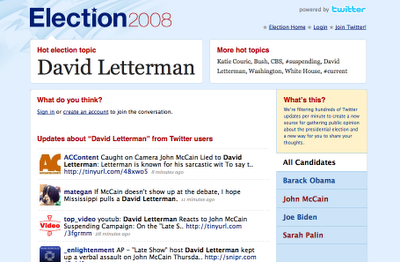Twitter's Election 2008 - more than a mashup; it's a revenue model

Twitter announced last night that it has kicked off its own Election 2008 mashup, creating a central hub on all popular political issues being discussed throughout the site. According to the blog:
During the first presidential debate in Oxford, Mississippi and each subsequent debate leading up to and beyond election day, Twitter will be performing real-time algorithmic analysis on millions of unedited public reactions. These trending topics along with a live ticker of continuously fresh opinions are available now at election.twitter.com.
By leveraging the power of its Twitter Search trend and search capabilities, Twitter has taken this mashup much further than the current third-party Politweets mashup. Twitter's Election 2008 is a live, real-time feed of all political commentary streaming through the microblogging network and it also includes sub-categories for some of the most widely discussed trends. There is no need for the popular hashtags approach. There's no need to manually create your own trending topics and create an RSS feed in order to join the conversations. Hot topic pages are already created and it's all automated. For example:

Biz Stone writes about the Election 2008 features in the Twitter blog:
- Hot Election Topics are determined by a variety of search queries
- The topics at the top of the page are updated every 15 minutes
- Clicking at topic filters the content based on that particular word or phrase
- Obama and McCain's Twitter accounts are updated whenever they update
- People can participate in the box under "What do you think?"
- The main timeline is a live ticker—new updates appear every second or so
- Clicking the sidebar tabs filters the main timeline by candidate name
- We'll be featuring notable Twitter accounts in the sidebar
- Updates made at Twitter E08 will link back to election.twitter.com
This is the first time that Twitter has gotten into the mashup game, and a good place to start considering the thousands of political posts occurring each day. The mashup is being promoted via a quick frame at the top of the Twitter main site and I've seen several people in my network promoting it via word-of-mouth this morning.
The mashup itself, while cool, isn't the most interesting piece. What's cool about this is that I believe it could give us a sneak peek into Twitter's plans for a potential revenue model -- about which speculation has abounded since it closed it's last round of funding. While selling ad space on the main feed could be seen as obtrusive to its users, and beyond a Google AdWords-type of approach, difficult to trend toward each user, advertising on a mashup would be profitable and potentially well-revered if done right.
Take at look at the layout of the main Election 2008 site. There is a lot of unused real estate that could be given to advertisers. Twitter has also designed the Election 2008 site so that even nonmembers can take in the content (but you need to be a member to participate). While the mashup streams content from throughout the Twitter network it behooves individual users who truly want to engage beyond their current networks to "tweet" directly from the mashup page. If Twitter clocks this traffic and can put some page view metrics into an ad kit, that could stand to be quite profitable for the company.
It's bigger than that, however. The trends don't stop at politics. Ever notice how many of your Twitter friends talk about professional sports? Music? Fashion and television shows? AMC could've easily sponsored a Twitter mashup that featured all of the "Mad Men" characters and allowed them to promote other shows and even bring in network sponsors to tap an entirely new Web-based audience.
What do you think? Could this be the start of a new revenue model for Twitter?